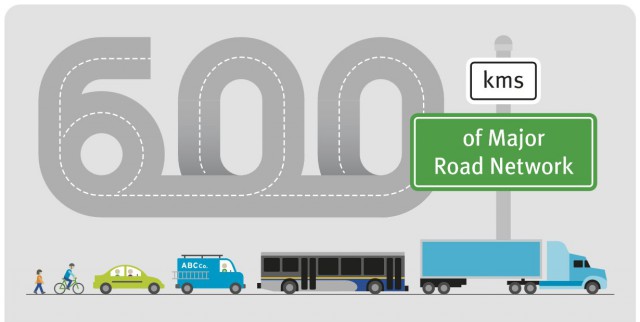TransLink commits more than $48 million to road and cycling projects
TransLink commits more than $48 million to road and cycling projects

As you may or may not know, TransLink is much more than transit!
Did you know that TransLink is funding more than $48 million in major road and cycling projects across Metro Vancouver’s municipalities in 2016?
That’s right!
Translink has committed $9.8 million towards 16 capital improvement road and bicycle projects in 12 Metro Vancouver municipalities.
We have has also committed $38.5 million to operate, maintain and rehabilitate the regional Major Road Network (MRN).
The MRN is a network of more than 2,300 lane kilometres (or 600 road kilometres) of arterial roads stretching across the region that carry the bulk of the region’s commuter, transit and truck traffic.
Funds* are used by municipalities for a range of activities, from street cleaning and snow removal, maintaining streetlights, traffic signals and signs, patching potholes, and repaving.
To get the inside scoop on the MRN and other projects around the region, I spoke with one of our very own engineers, Sam Young.
What type of work do you do for TransLink?
I am a Transportation Engineer and have been with TransLink’s Infrastructure Program Management Department for about three years. We have lots of projects on the go, and I am part of a team that works closely with Metro Vancouver municipalities to fund the maintenance, operation, and upgrades to the Major Road Network, as well as upgrades to the regional cycling network. Our team also works with internal and external stakeholders to make sure that new and existing TransLink services and facilities, such as bus routes and bus exchanges, can operate safely and efficiently.
Can you tell us about how the MRN was formed?
When TransLink was formed in 1999, it became the first multi-modal transportation authority in North America responsible for not only transit within Metro Vancouver, but also cycling, roads, as well as goods movement within the region.
The MRN was born around the same time, comprising of roads across the region that were either declassified from the Province (such as Lougheed Highway and King George Highway), or uploaded from the Municipalities (such as Knight Street and Broadway). At that time, a systematic evaluation was done to assess which roads would be included as part of the MRN; but generally speaking, a Major Road would typically play a significant role in providing mobility and connectivity across our region.
If you study the MRN map closely, you’ll notice that the majority of Major Roads are important transit and goods movement corridors, link multiple municipalities and activities centers, and connect to the Provincial Highway system for travel through the region or outside the region.
What are some major projects that have been completed in years past, that readers might be able to recognize?
Some of the recently completed projects with TransLink funding include the Low Level Road Project in North Vancouver, the Powell Street Overpass Project in Vancouver, the Moody Street Overpass Upgrade Project in Port Moody, and the Fraser Highway Widening projects in Surrey and Township of Langley.
What is the benefit of these investments to each municipality?
Not many people know this, but TransLink also provides funding towards the day to day operation and maintenance of the MRN, including snow removal activities, street cleaning, pavement maintenance such as patching of potholes as well as sidewalk and bike lane maintenance.
MRN: by the numbers
- The MRN is approximately 2,360 lane-km in length, which is long enough to stretch from Vancouver to San Diego!
- In addition, TransLink also owns and maintains a portion of the MRN. The MRN extends through three TransLink owned bridges (Golden Ears Bridge, Knight Street Bridge, Pattullo Bridge), as well as Golden Ears Way. There are over 200,000 vehicle crossings on these TransLink bridges every day.
- When the MRN was formed in 1999, it was only about 2,200 lane-km in length. About 30% of this original network consisted of declassified Provincial roadways. Over the years, the MRN size has increased due to additional major roads being added, road widening projects, and intersection improvement projects such as new turn lanes.
- There are over 1,000 traffic signals on the MRN alone – the funding TransLink provides also goes towards the operation and maintenance of signals. The replacement of these signals systems occur when they reach the end of their useful lives. Same goes for street lights!
Thanks to Sam for some MRN insights!
For more information you can visit our
Roads, Bridges and Goods Movements Projects page.
Author: Jordan Keim and Adrienne Coling
*Funding is provided per kilometre of MRN within each municipality.





